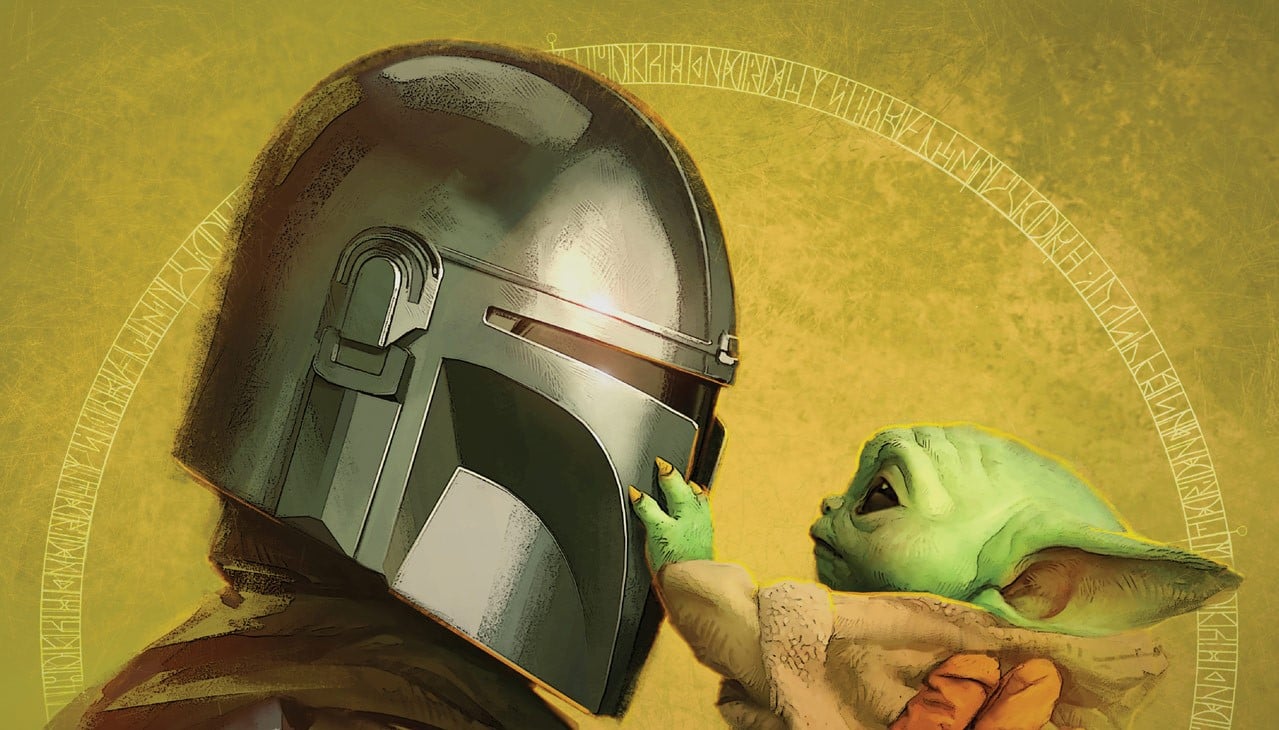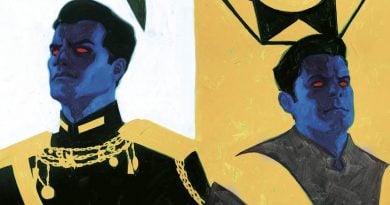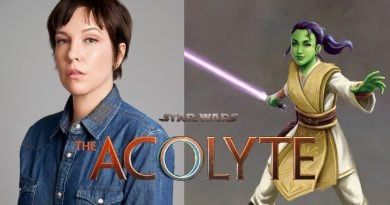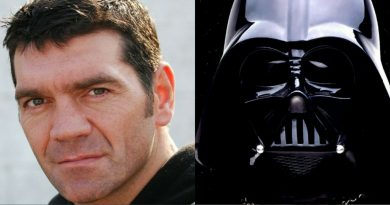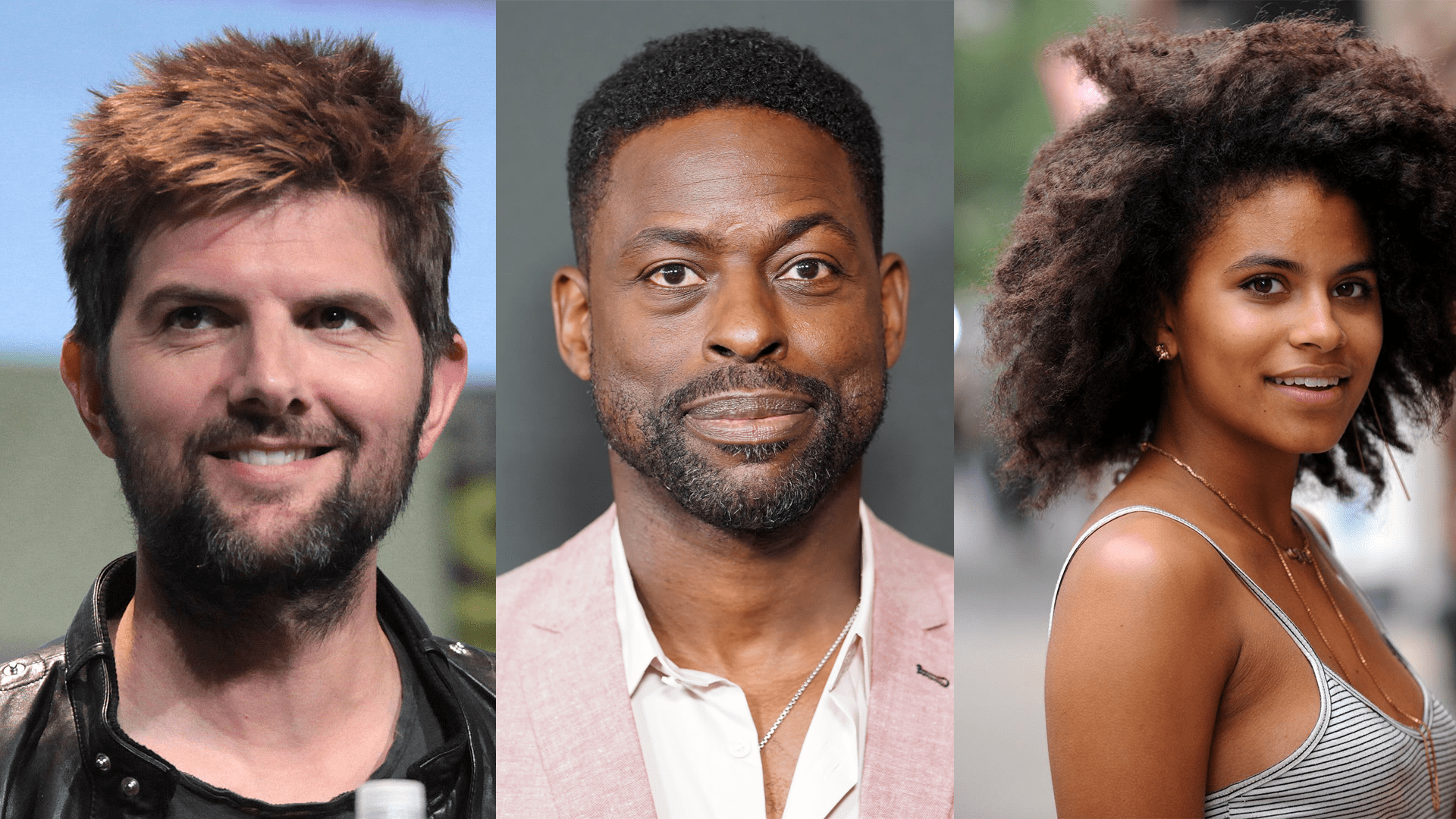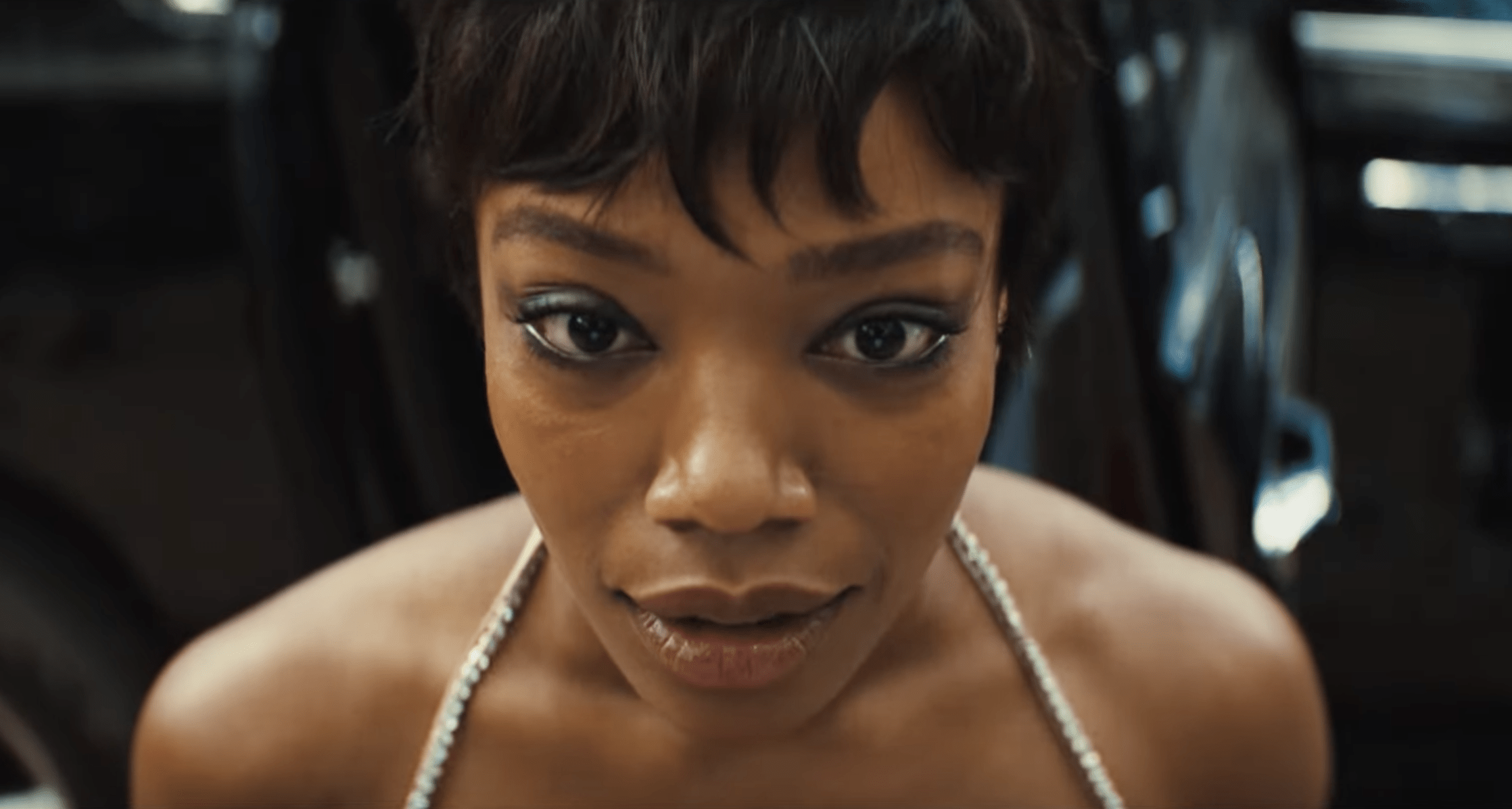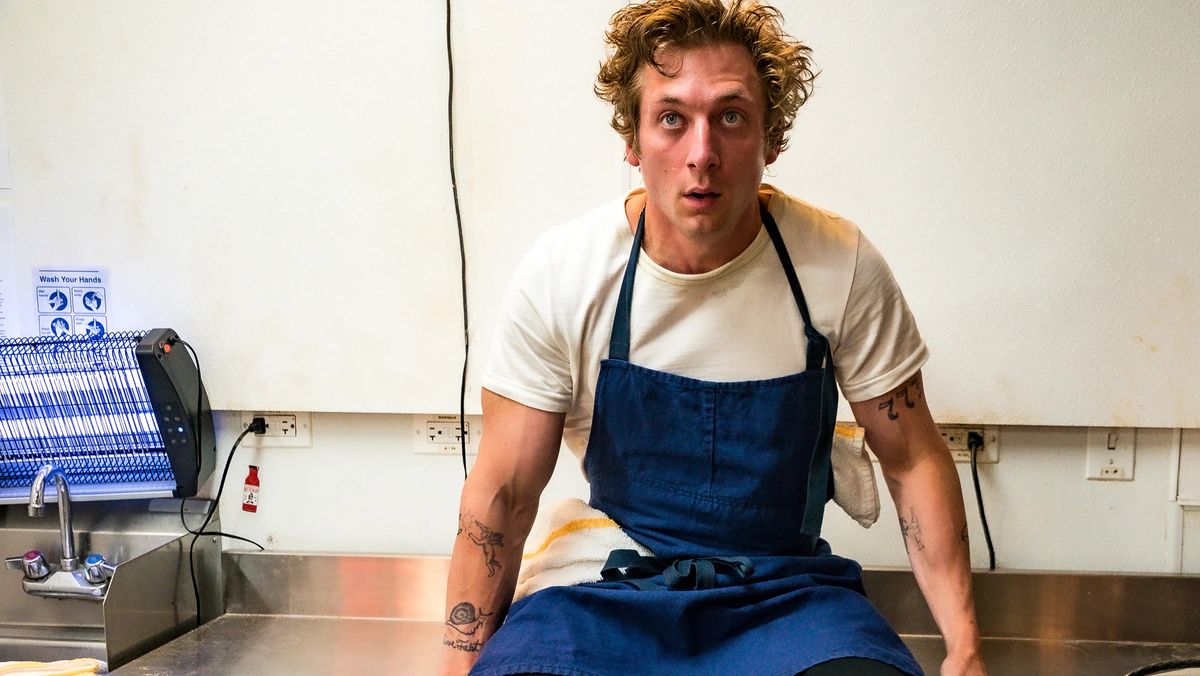Expanding the Universe – Going Behind the Scenes with ‘The Art of Star Wars: The Mandalorian (Season 2)’
In addition to the incredible concept art, The Art of Star Wars books always offer fascinating glimpses behind the scenes at how the stories we love are created. From fun trivia to world building insights, The Art of Star Wars: The Mandalorian (Season 2) is no exception, so we’ve dug through Phil Szostak’s recently released visual feast to share some of these with you.
Going Back to Basics
The use of concept art in The Mandalorian draws heavily on two of George Lucas’s key principals. The first is letting the art guide the story, with initial story ideas generating concept art that then guides the direction of the story, creating what Szostak calls a symbiotic approach between the screen writers and the art department.
“I’ve leaned on the art department since the beginning [of the series]. As I would write, I would show Dave. Dave would sketch, then we’d start sending Dave’s sketches over to Doug. [The art department] started doing fully formed versions of [those sketches], and that would get me writing more. Sometimes I would even say to Doug, ‘Hey, I haven’t written this yet, but I’m thinking of a location like this, and this is what’s going to happen there,’ and then let the drawing inspire the scene. They make it more exciting for me to write it. Or I’ll get ideas from the visuals that I’ll use in the script.
The thing that’s cool about Doug and the art department is, I might write a scene, but when I see it rendered in a Star Wars style, with all the details, all of a sudden it feels like a real Star Wars thing. It goes from an idea on my laptop to something I can look at, that looks like a frame out of the show. It’s like being able to look into the future. And now I understand the scene better. Then it’s like a game of telephone, where each idea get built upon, except in a positive sense. Everyone changes it a little bit, and if there’s ever anything that doesn’t feel right for the story, you can give notes. More often than not, the new ideas are inspiring.”
Jon Favreau
The second is in the use of silhouette to create immediately identifiable characters. As Doug Chiang notes:
“The guidelines established by George Lucas are simple: Design as if a child could draw it. Design for the silhouette. Design for the iconic logo. Keep it simple. Give it personality and make it believable. When audiences see a design, they perceive the shape first. And they need to understand what they’re looking at in seconds, so silhouette is critical. Color and details come next, and they complete the design but don’t define it.”
Doug Chiang
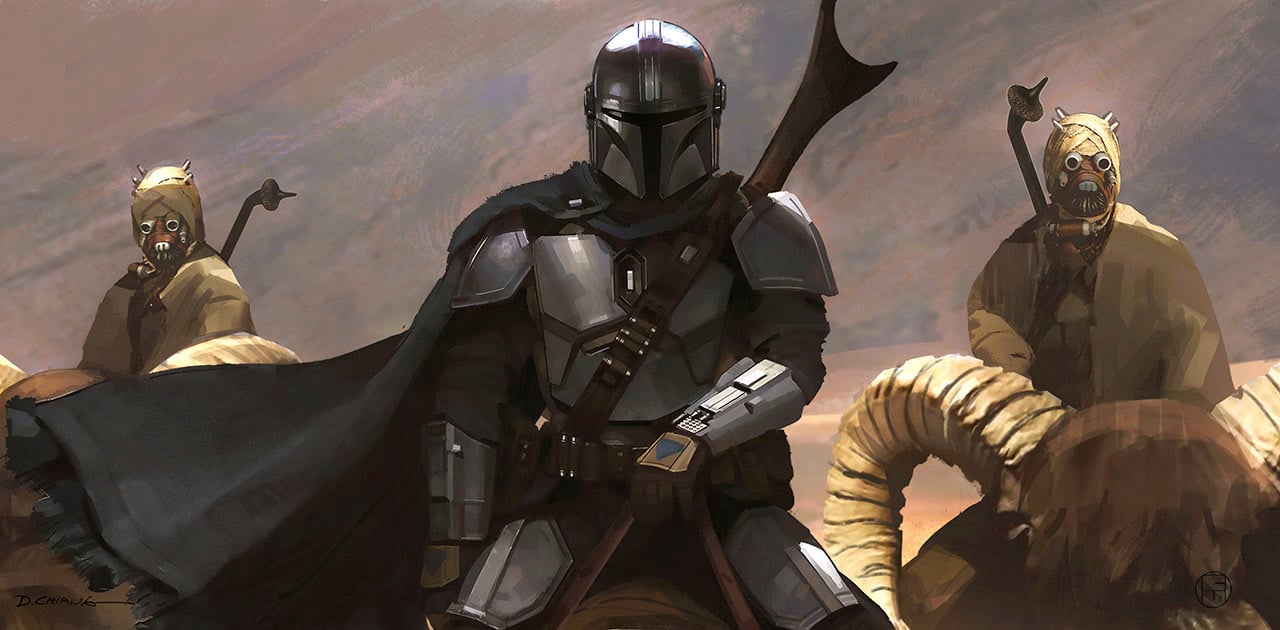
Indeed, this concept is something that was on Favreau’s mind when he decided that the Mandalorian would not remove his helmet:
“There were a few things I wanted to explore. One was why we didn’t see a lot of Mandalorians in the original trilogy and sequels. You see them so much in Clone Wars, but you don’t get to see any them now. The other was, how do you get back to what George did, which was treat the characters almost like action figures? How do you get back to how young kids interact with Star Wars, the colors and shapes and characters? By keeping [Mando’s] helmet on all the time. It’s not about the face under it, it’s about the helmet. Same with Boba Fett; you don’t think about what’s under the helmet, you think about that mysterious silhouette. I wanted to preserve the magic of that, or return it to that, knowing full well that we would get complex later, that there are some groups that stick to the old rules and other groups that have evolved, like Bo-Katan’s group, that are dealing more with the politics of the moment. Having those two meet each other and contend with one another was a way to address that.”
Jon Favreau
The one key difference with George Lucas? Time. As Doug Chiang notes in his introduction, The Mandalorian requires as much art design as two or three feature films in a third of the time and with half of the budget. It’s an incredible challenge, but one that the team has clearly risen to.
Mos Pelgo – Bringing the Wild West to a Galaxy Far, Far Away
One of the things the art team did a lot in season 2 of The Mandalorian was to expand the universe in ways that were new but at the same time familiar. We all know that George Lucas was influenced by westerns and Kurosawa, so seeing those influences in The Mandalorian instinctively feels like a natural fit. But The Art of Star Wars: The Mandalorian (Season 2) dives a little deeper, examining what the team did to really bring those settings into Star Wars, how that design was influenced by the story, and how they used design to tie the trilogies together.
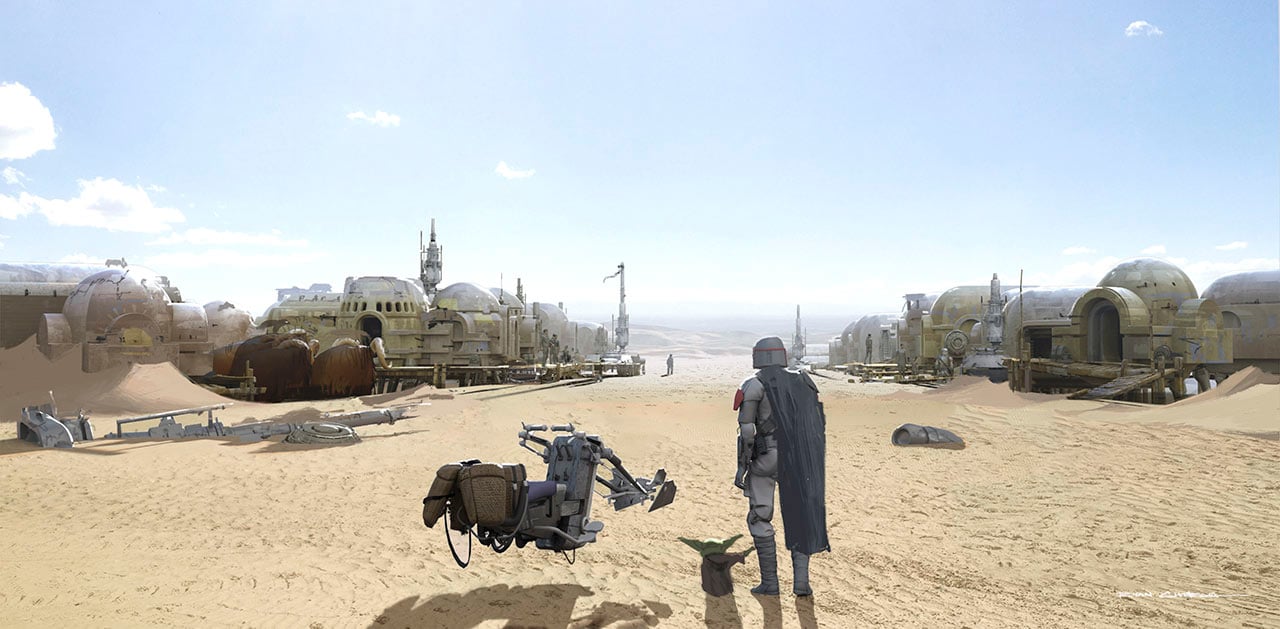
“Take, for example, the town of Mos Pelgo on Tatooine, where Mando finds Cobb Vanth and his extraordinary armor. This new location could have easily resembled the established cities of Mos Eisley or Mos Espa. To make it fresh and original, we turned it into a classic Western town with a single main street and then raised the buildings on stilts to give it a distinct characteristic that we hadn’t seen before. The result is something familiar yet unique.”
Doug Chiang
Those stilts gave the town a more Western look and feel, but they also served an in-universe purpose. According to Chiang, the stilts and decking helped the people of Mos Pelgo avoid vibrations that would attract the krayt dragon. There was a little cheating, as concept supervisor Ryan Church noted, wooden walkways don’t make the most sense on a desert world, but the sound of feet on wood was desired for that Western vibe.
As well as something new, there was also something old to the design:
“You’ll notice the bar counter looks very much like Watto’s table in Mos Espa [from The Phantom Menace]. That was, again, trying to bridge and connect all of the design language for Tatooine.”
Doug Chiang
Jaws, the Krayt Dragon, and George Lucas’s Swimming Pool
The original krayt dragon skeleton, glimpsed in the desert in A New Hope, was a diplodocus prop salvaged from Disney’s One of Our Dinosaurs is Missing by set director Roger Christian and ultimately left in the Tunisian desert once filming was done. For The Mandalorian, the krayt dragon received a more monstrous upgrade.
“We saw the [krayt dragon] skeleton in A New Hope, and Terry Whitlatch [Star Wars creature designer] did some beautiful drawings. These early explorations were really trying to figure out, ‘What is the design of the head so that it doesn’t conflict too much with the skull that we saw in the desert?’ But then we realized, because this is the mature version of the creature in our storytelling, we should make it more interesting, more dangerous. So it was kind of a reverse evolutionary process. Is that a female? Is that a young one?”
Ryan Church
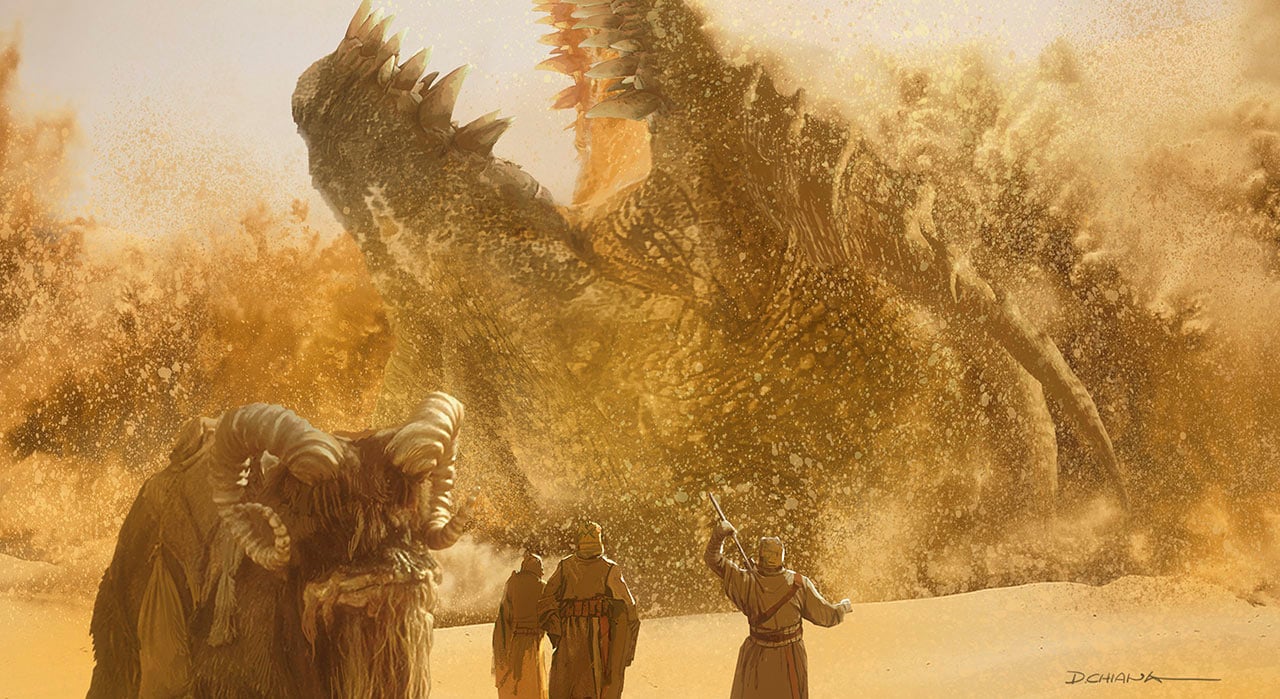
Whilst the full dragon was designed, and can be seen in The Art of Star Wars: The Mandalorian (Season 2), the idea was never to show that on screen. Jaws is cited as a big influence on that direction, with Chiang noting that Favreau wanted “to keep it very peekaboo,” and concept supervisor Christian Alzmann saying he was “probably vibing off that [Jaws poster]” when designing the creature.
With Jaws as an influence, the designers toyed with the idea of a fin for the dragon as it swam through the sands of Tatooine. The fin would also be a call back to a creature from The Empire Strikes Back, with Alzmann revealing a surprising detail about just where some of that classic film’s pickups took place:
“It’s pretty similar to the dragonsnake we see in Dagobah that was shot in George Lucas’s [unfinished] swimming pool [which stood in for the swamp during The Empire Strikes Back pickup shots in early 1980]. I wanted to emphasize the scale of this dragon charging and was referencing Tremors and Dune.”
Christian Alzmann
Asian Elephants and Banthas
In a callback to A New Hope, Asian elephants again were used to bring banthas to life, only this time utilizing modern technology and 3D printing:
“The bantha was sculpted over a 3-D print of an Asian elephant [the banthas seen in 1977’s A New Hope were played by a female Asian elephant named Mardji], which turned out to be a real time saver and helped reduce the weight of the clay model. It remained in its clay form, and multiple photos were shot as reference for the eventual physical prop and CG versions.”
Tony McVey
Nomad Boba Fett Inspired by Lawrence of Arabia and Sideshow Collectibles
Both Doug Chiang and concept artist Brian Matyas confirm that Boba Fett’s nomadic look, with black robes and Tusken bandoliers, was inspired by the classic Lawrence of Arabia, but Matyas goes on to note that there was also another, perhaps more surprising, influence – Sideshow Collectibles!
“I was also really inspired by the Sideshow Collectibles Ben Kenobi Mythos statue, the collection of items on his back and not concealing what you’re collecting.”
Brian Matyas
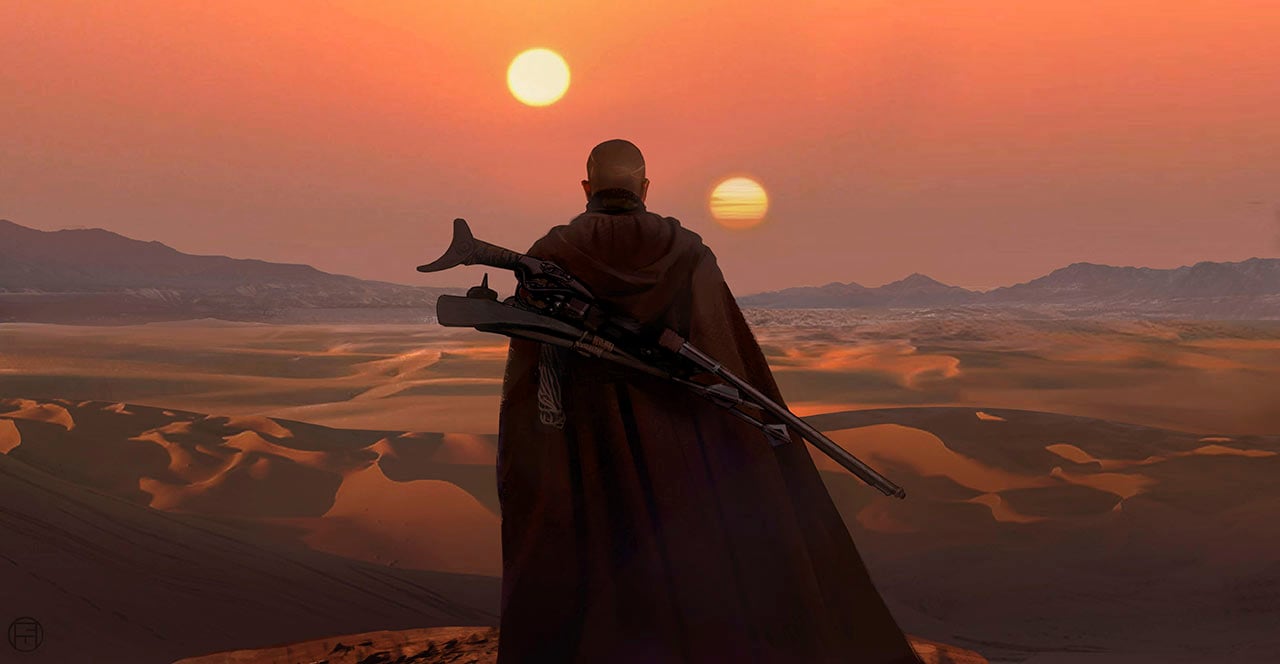
All Fans on Set
Whilst technical ability is, of course, essential. Being a fan is just as important. Peyton Reed, who directed two episodes in the second season, was chosen by Favreau following a set visit by the Ant Man director during season 1.
“We want to make sure that [the people we hire] are either fans already or excited by it, because there’s a tremendous amount of work that has to be accomplished in a very short amount of time. It can’t feel like work, it has to feel fun, otherwise, you will never get it done. You’re surrounded by other people who feel the same way. And Peyton is that kind of guy.”
Jon Favreau
A year after that set visit Reed, was behind the camera for Chapter 10: The Passenger, before coming back again to direct the season finale and the historic return of Luke Skywalker.
Diana Inosanto, who played the Magistrate in Chapter 13: The Jedi, would also turn out to be a fan. “When we called her in, [we found out that] she’s somebody who watches Clone Wars and Rebels with her kids,” Filoni revealed, “And she was just ecstatic. I said ‘Well, you know who you’re going to fight, right?’ She almost fell over right there.”
The Passenger – From the Background to Featured Character
Whilst most fans only came to know her in season 2, the Frog Lady actually appeared in The Mandalorian’s first season as well.
“Both Dr. Mandible, the giant ant-like alien playing cards with Peli Motto, and Frog Lady, the eponymous passenger, appeared in the Mos Eisley cantina as background characters in “Chapter 5: The Gunslinger“.”
Phil Szostak
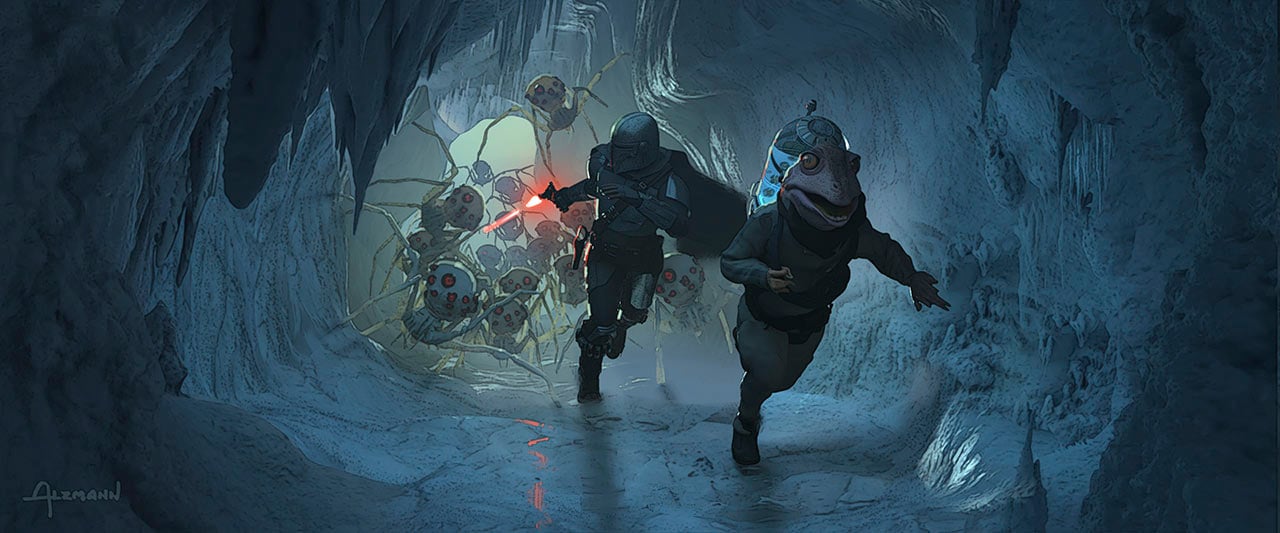
McQuarrie’s Influence
Star Wars legend Ralph McQuarrie influenced more than just the spiders in Chapter 9: The Passenger. He also influenced the hot springs through work done for one of the early Star Wars guide books.
“I remembered an old Ralph McQuarrie painting for the Illustrated Star Wars Universe book where he painted these hot springs underneath Hoth, with grass growing and tauntauns. And I thought, ‘Well, wouldn’t it be fun to do that here, to create a hot spring?’ And you could have life down here because it’s warm.”
Doug Chiang
His influence is also felt later in the season, on Corvus, where his early Return of the Jedi work helped to inspired the look of the city:
“While doing research I looked through my Ralph McQuarrie books and found these [1980-1981 early Jabba’s Palace] sketches that inspired my direction for the first drafts of the city.”
Anton Grandert
The eye, another nod to Jabba’s Palace, remained in the middle of the main gate in the finished episode.
British Weather Inspired Trask
Maybe it’s because I’m British, but this one just tickled me. Our infamous bad weather is now immortalized in Star Wars as the influence for Trask.
“I had taken a drive out with a friend of mine from London to the east coast [of England], where the Thames River meets the ocean. It was a dark, overcast day, and it was that day that I was trying to get into all of these illustrations. Evocative. And I never changed the illustration style, the time of day, ever, in any of these illustrations.”
Ryan Church
Jyn’s Rogue One River Cruise
Taking a quick detour from The Mandalorian, it turns out that Jyn Erso was originally going to take a river journey to find Saw Gerrera. Does anyone remember the very first teaser for Rogue One? Shown way back at the Future Filmmakers panel at Celebration Anaheim in 2015, and leaked online soon after. The teaser was never officially released outside of the convention but, according to Chiang, the footage shown was (presumably concept work) for that river journey.
Whilst Jyn’s river cruise may have been cancelled, the Star Wars design team never let a good design go to waste, so Thom Tenery’s Rogue One design was tweaked and re-purposed for the fishing trawler in Chapter 11: The Heiress.
“We took an old design that we had developed for Rogue One, for the river journey [where Jyn Erso was initially going to find Saw Gerrera, as seen in the teaser trailer shown at Star Wars Celebration Anaheim 2015], and basically scaled it up to be this fishing trawler. We needed a big cargo hold in the center, where this sea creature was going to be.”
Doug Chiang
Mini Monster
This is one of those world building details that would never have even crossed my mind without this book. It turns out that Grogu’s cockpit attacker at the end of Chapter 11 is a younger version of the monster from the trawler:
“The squid had to be a little version of the thing that swallowed him up in the boat. And I figured it would be like the way baby crabs are. Crabs have these tiny little things that you barely recognize as crabs. It definitely has a facehugger kind of vibe when it’s that size.”
Christian Alzmann
The Cantina Became the School
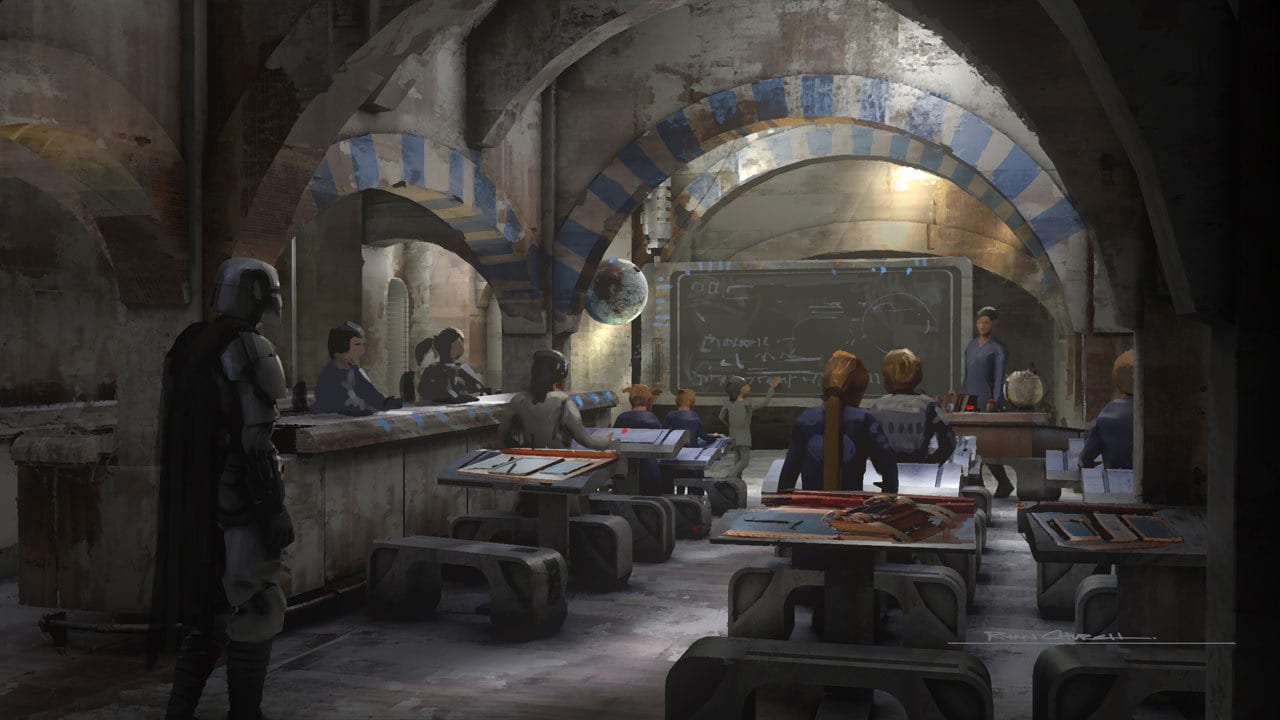
Another fun piece of world building, or world evolution I guess in this case, is that the school on Nevarro is actually the cantina that Mando and Greef Karga used to do business in. An idea that came from Jon Favreau himself.
“Jon wanted to refurbish the public house, because we saw it completely destroyed in Season 1. Now [the people of Nevarro] have fixed it up and turned it into a schoolroom.”
Doug Chiang
And, on the subject of the school, they also spent “a week or so” designing the cookies for Gorgu to steal.
Nevarro’s Imperial Base Links Rogue One and The Force Awakens
In another example of using design language to link the saga together across all eras, the art team drew on both Rogue One and The Force Awakens when it came to establishing the look of the Imperial base on Nevarro.
“Doug said ‘Let’s do the Rogue One thing [in designing this Imperial base],’ because that’s what the Empire does when they go into a site. Jon wanted the audience to immediately understand how hidden it way. I initially put the Rogue One module on the top surface of the cliff. And Doug was like ‘No, it’s literally very much like the Rogue One thing.’ But then, ‘How much rock is above it? How big is the overhang?’ There was a lot of circling and honing that detail in for Jon. ‘Are the guns on top? Are they smaller?'”
Ryan Church
Digging into the rock allowed them to utilize another idea first seen in The Force Awaken’s Starkiller Base:
“We wanted to try this idea from Episode VII: putting rock-carved hallways in every once in a while, like they’re perfectly laser-cut. We know that’s a part of the Empire’s tool kit.”
Doug Chiang
Another link to sequel trilogy design would be seen in Chapter 14: The Tragedy, with the new Imperial transport designed as a precursor to the First Order troop transports first seen in The Force Awakens.
Ahsoka and The Child / Filoni, Favreau and Lucas
Bringing Ahsoka from animation to live action was a possibility that was on Dave Filoni’s mind from very early in production. “There were a lot of things that I wanted to do with the character,” he said, “But how can I do it, make sure I’m getting it right, and have as much control over the situation as possible?”
And then there was the issue of Grogu, and his back story. Where had he come from? How much did he know about Force? As the story of season 2 progressed, it seems these two threads naturally came together.
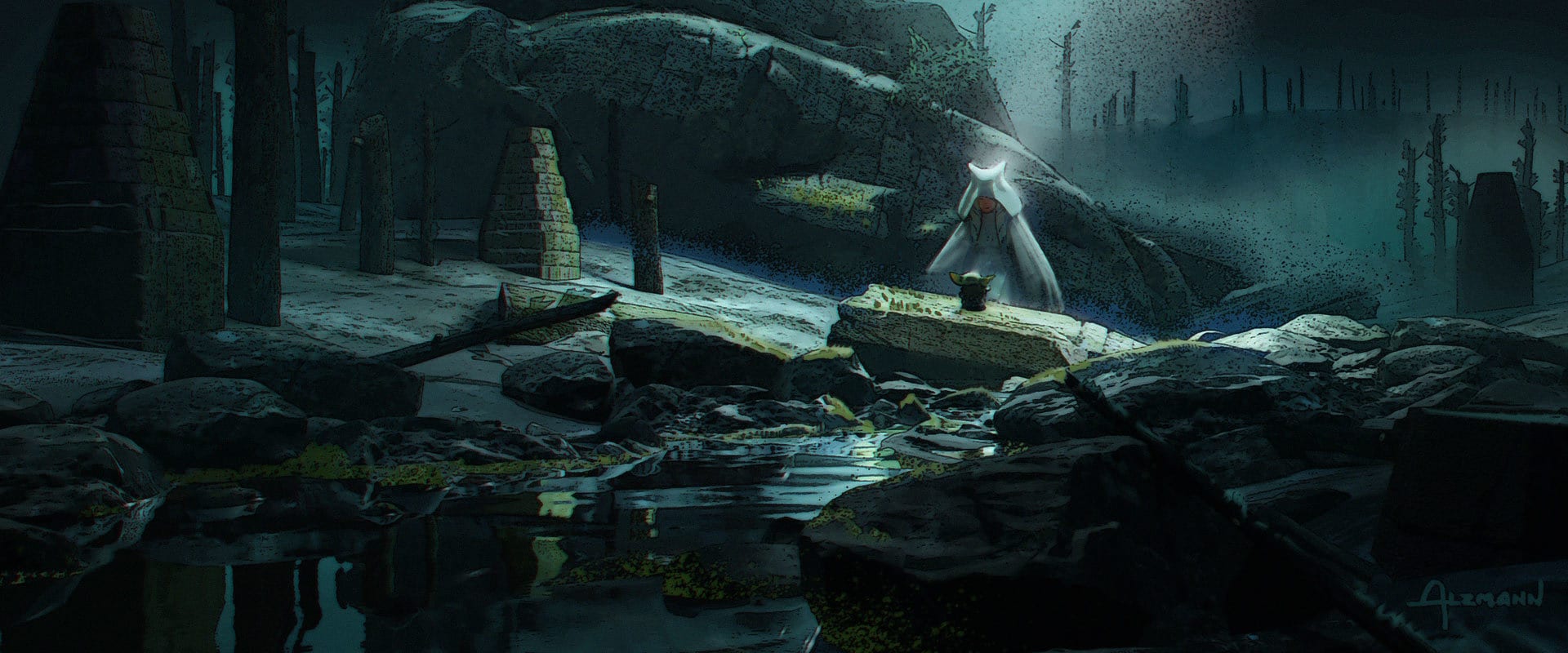
“I had a talk with George, at one point, about the Child, and his main concern was that the kid has to have a proper amount of training.
I [also] started talking to Jon about the possibility that Ahsoka could actually learn the Child’s name because she’s the only person who could actually talk to him. And that’s where I was having ideas of them listening to each other’s minds. I was really interested in that moment and that scene.
It was pretty astonishing, I’ve got to say. Jon let me go in there and write this episode about the Child, which introduced his backstory. He told me the kid’s name, because he named him. Jon knows that I’m very protective of Ahsoka and her history and what she’s about. We went through a couple rounds where I’d write a bunch then he’d look at it and give me his take – that perspective becomes really valuable for me to then communicate this character that maybe the larger audience doesn’t know but the fans do. And get at the root of what makes her special.”
Dave Filoni
Though The Art of Star Wars: The Mandaloran (Season 2) does not reveal what Lucas thought of the solution Filoni and Favreau arrived at for Grogu’s past training, it seems reasonable to assume he would be happy with it given that Filoni is unlikely to have done something if he knew it went against Lucas’s understanding of how the Star Wars universe works.
Ahsoka’s Cloak and the Depth of Her Character
If you look very closely at Ahsoka’s cloak in Chapter 13: The Jedi, you will see that actually isn’t gray. At the request of Dave Filoni the art team drew inspiration from artist N. C. Wyeth’s Winter, with her cloak shot through with hidden color. It’s an effect that is arguably more noticeable in the concept art that the finished costume, but if you look closely you can see the multiple colors woven subtly into the fabric.
“If you look at Ahsoka’s cloak closely, there are actually many, many colors woven into it. That was a brilliant thing that Costumes did to make it feel like the mix of colors in that painting. It’s almost iridescent. There are all of these layers of Ahsoka. You think you see her, but she’s actually deeper and has more intricacies and history that people know.”
Dave Filoni
Grogu’s Force Powers
Going off the concept art Grogu was originally going to show greater strength in the Force during his meeting with Ahsoka, with early sketches featuring him lifting rocks like Rey on Crait and bringing flowers back to life on the industrially pillaged world.
“I thought a really interesting use of the Force would be bringing something back to life. Especially on this gray planet. What a beautiful thing if that’s what the Child represented, a rebirth.”
Christian Alzmann
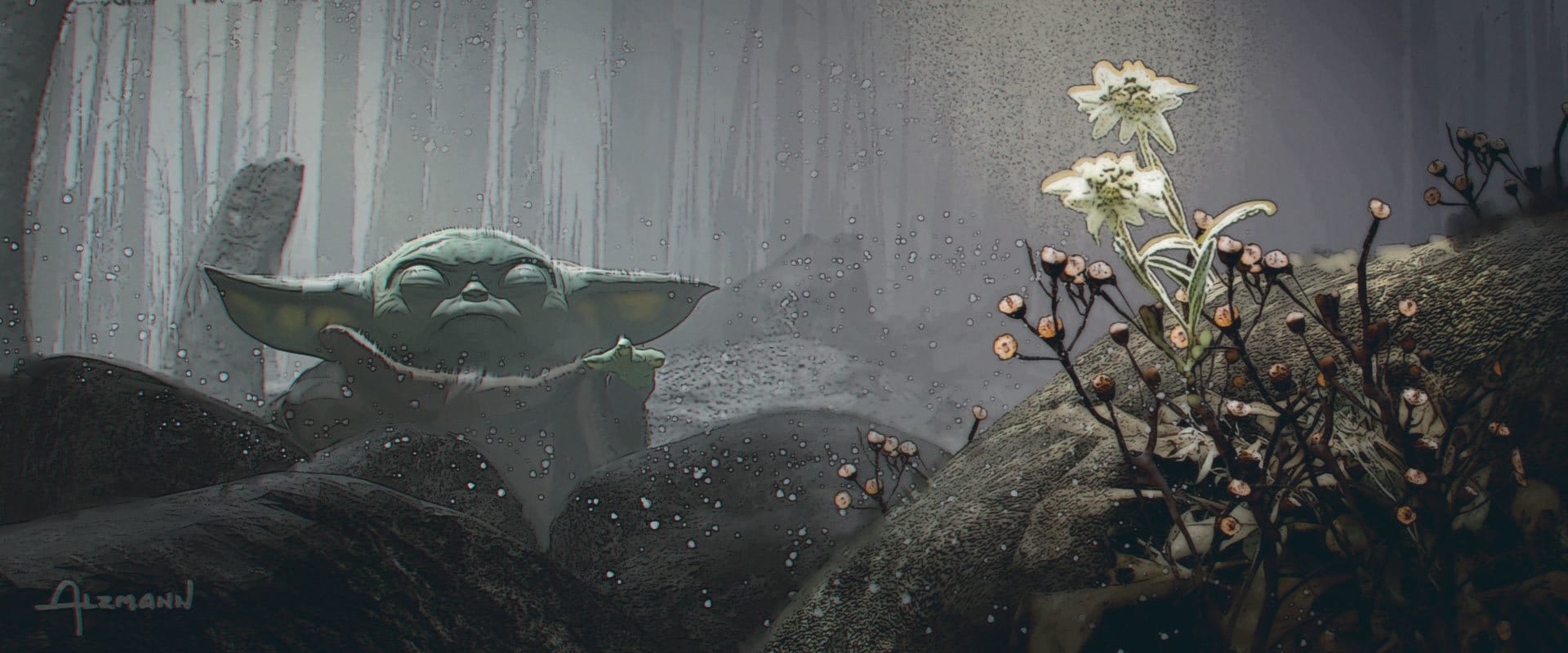
Though both have precedent from the show’s first season, where he stopped the mudhorn and healed Greef Karga’s wounds, the moment was ultimately toned down for the final episode.
Michael Biehn Helped Develop His Character
It’s always interesting to hear how much, or how little, input actors get into their characters, so I found it very insightful to read Filoni discussing what Michael Biehn brought to Lang and his honest acknowledgement that Biehn brought the character to life in a way that his script didn’t.
“[Lang actor] Michael Biehn made a huge impact on the episode because, while I had developed Ahsoka and her role and the magistrate, Lang’s character, to some degree, had become just a hired gun. So Michael had all kinds of questions. And his experience of playing these types of characters, going back to Johnny Ringo [from the film Tombstone], was invaluable. Michael had a whole philosophy for how his character would try to take out somebody like Mando, who he logically thought would be younger and better than him. So he brought a reality and a nuance to the character that really brought him to life in a way that I did not have on the page.”
Dave Filoni
Common Designs Between Jedi and Sith
When designing the ruins of the Tython’s “Force-henge” the art team wanted a natural look but also something that was unique to Star Wars. The design brief was essentially “Stonehenge mixed with Vasquez Rocks [Natural Area Park] in Southern California,” but to get that Star Wars look they went back to Rogue One, again seeking that common design language that helps to subconsciously tie the universe together.
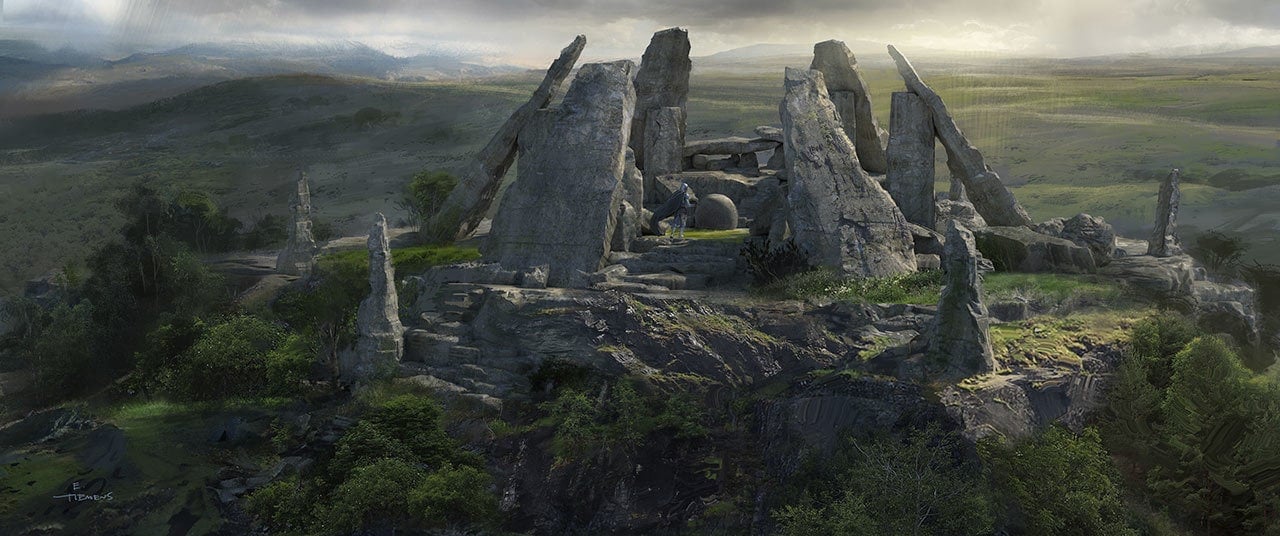
“We wanted to communicate that these rocks are helping to channel the Force energy, so we angled them in to look like a funnel that can direct and focus that energy, not unlike Vader’s castle or the Jedha temple’s [from Rogue One] ‘tuning forks.’ It all has that same form language”
Doug Chiang
Grogu’s Cell is Inspired by Leia’s
If you’ve see one Imperial cell, you’ve seen them all. As noted by Doug Chiang, Leia’s prison cell on the Death Star prison cell served as inspiration for Grogu’s on Gideon’s ship. The only difference? They needed to make this one a little bit bigger so Grogu had room to throw around the stormtroopers.
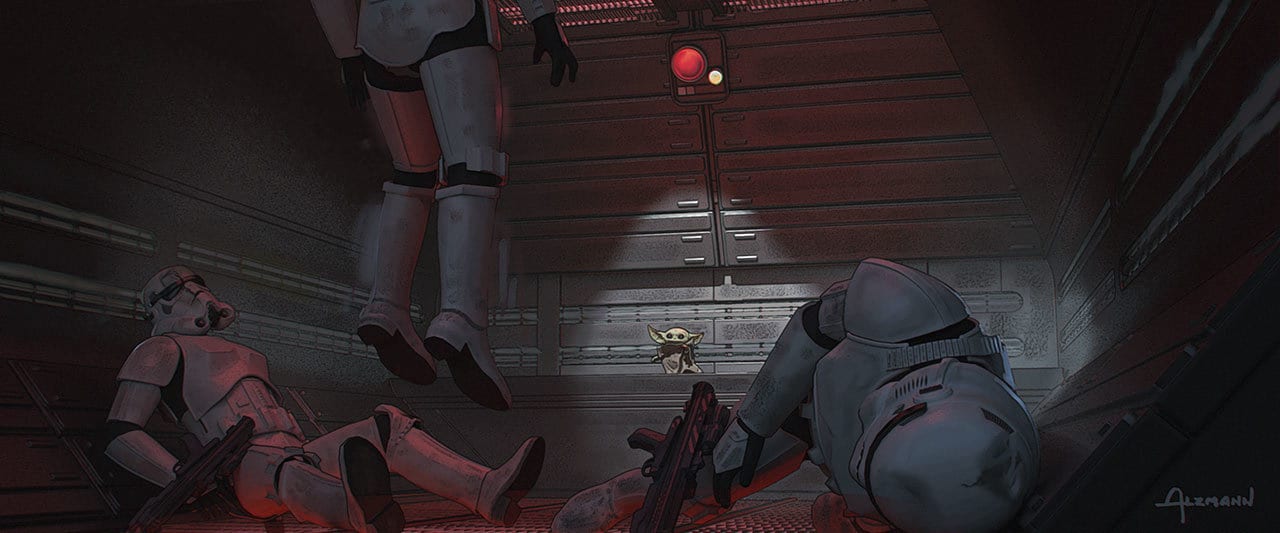
The Volume Doesn’t Like Direct Sunlight
This one surprised me! As much as we hear about the volume, many scenes taking place in direct sunlight are actually filmed on the backlot as “that quality of light remains difficult for the StageCraft volume’s LED screens to replicate.”
Chapter 15: The Believer features several examples of this, including the main action sequences on top of the transport and the rooftop escape from the refinery. These backlot shots then layered in pre-existing photogrammetry of the Maldvies, which had originally been taken for Rogue One, to create Morak’s thick jungle environment.
Bo-Katan’s Ship was too Big
Translating things from animation to live action can be a fine balance, and when the time came to recreate Bo-Katan’s Gauntlet starfighter in live action the art team found that size definitely matters.
“We realized that, in real life, Bo-Katan’s ship was just way too big. It was almost twice the size of the Falcon, which didn’t make much sense. So we kept scaling it down, scaling it down, while keeping it true to its animated origins.”
Doug Chiang
It’s still a big ship for a starfighter, but a little more proportionate than the animated original.
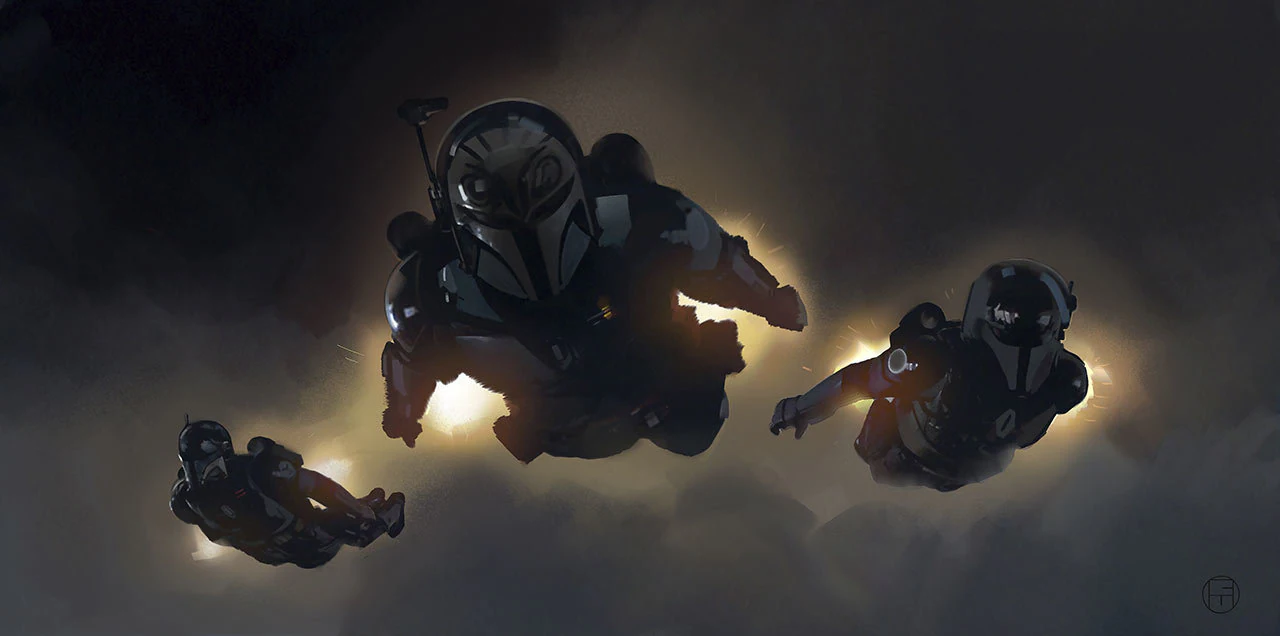
Luke Returned as Filoni has Other Plans for Ahsoka
Perhaps one of the most intriguing nuggets of information comes near the end, when the book examines the arrival of Luke Skywalker in the series as he came to save the day and take Grogu away to restart his training.
“There were a lot of debates about [Ahsoka Tano pointing the way to Luke Skywalker]. And Jon and I went back and forth, because if [Ahsoka can’t take care of Grogu,] then who will? Taking care of the Child is not her destiny. That’s not what I’ve been planning for her to do [laughs], so I can’t change it up. But it is interesting if Ahsoka’s there along the way, not as somebody who takes this burden away from Mando but as somebody to say, ‘You might be forgetting that this kid has a choice too. It’s not just about you and your oath to your covert.'”
Dave Filoni
Of course Filoni has plans for Ahsoka! And, whatever they are, from his comment here it seems that they’ve not been altered too much by bringing her into the world of The Mandalorian.
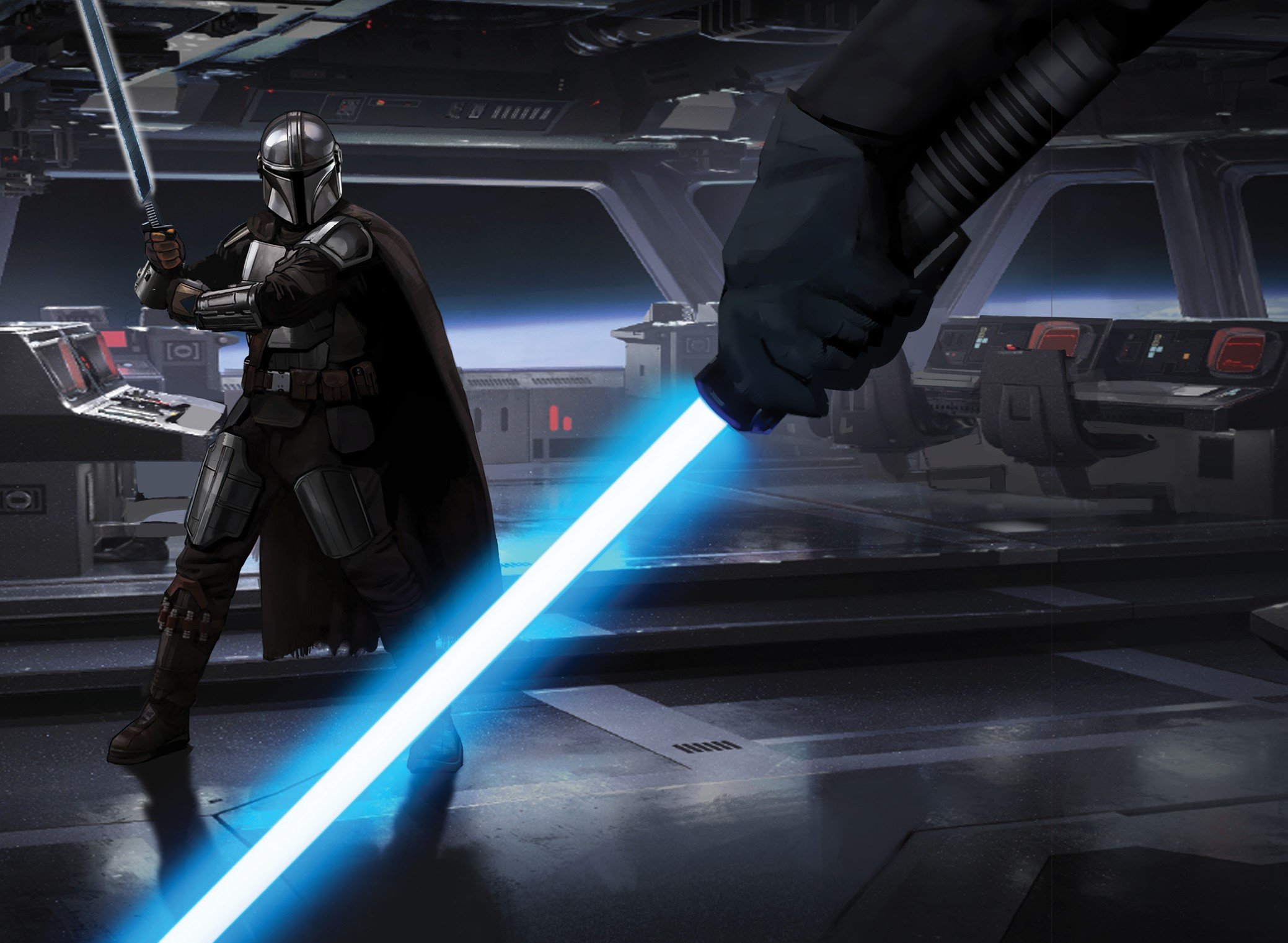
Razor Crest Rescue
During the early development of the season finale, concept supervisor pitched the idea of the Razor Crest ramming into Moff Gideon’s Imperial cruiser and crashing through the bridge as part of the heroic rescue attempt.
“I said, ‘Well, we’ve got the Razor Crest cockpit as a real build and we have the bridge as a real build, let’s mash them together.’ You’d see the horizon tilt and stormtroopers getting sucked out into space.”
Ryan Church
As cool as that sounds, there was of course one small problem that the art department didn’t know at the time. The Razor Crest was to be destroyed a few episodes earlier. Still, it sounds like a fun idea and, as this book has shown, the art team often return to ideas and concepts when working on future projects, so who knows where a version of this may turn up one day.
This is just a small taste of what The Art of Star Wars: The Mandalorian (Season 2) has in store. Phil Szostak has put together an incredible selection of artwork from across the entire season, along with fascinating insights into the world of the show and what goes into bringing that world to life. I would highly recommend it to any fan of the series.
The Art of Star Wars: The Mandalorian (Season 2) by Phil Szostak is available now.
Chris is a lifelong fan of Star Wars, Disney, and super heroes who can’t quite believe this golden age of movies and TV we’re living in. Having written blogs dedicated to Disney’s Aladdin musical and Star Wars Celebration, Chris is excited to be part of the SWNN and MNN teams.

